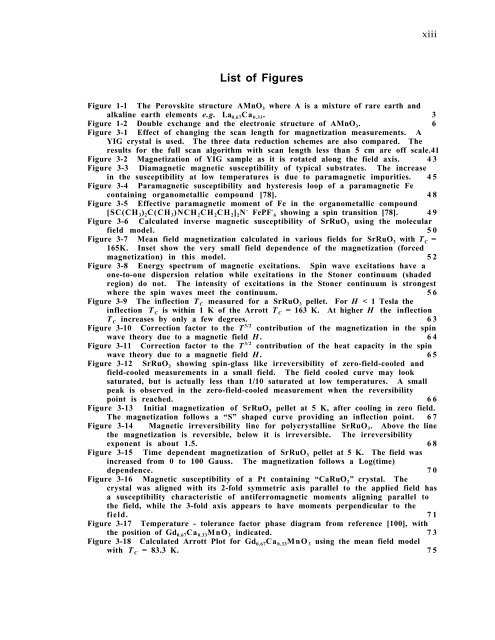MAGNETISM ELECTRON TRANSPORT MAGNETORESISTIVE LANTHANUM CALCIUM MANGANITE
MAGNETISM ELECTRON TRANSPORT MAGNETORESISTIVE LANTHANUM CALCIUM MANGANITE
MAGNETISM ELECTRON TRANSPORT MAGNETORESISTIVE LANTHANUM CALCIUM MANGANITE
Create successful ePaper yourself
Turn your PDF publications into a flip-book with our unique Google optimized e-Paper software.
List of Figures<br />
xiii<br />
Figure 1-1 The Perovskite structure AMnO 3 where A is a mixture of rare earth and<br />
alkaline earth elements e.g. La 0.67Ca 0.33. 3<br />
Figure 1-2 Double exchange and the electronic structure of AMnO 3. 6<br />
Figure 3-1 Effect of changing the scan length for magnetization measurements. A<br />
YIG crystal is used. The three data reduction schemes are also compared. The<br />
results for the full scan algorithm with scan length less than 5 cm are off scale.41<br />
Figure 3-2 Magnetization of YIG sample as it is rotated along the field axis. 4 3<br />
Figure 3-3 Diamagnetic magnetic susceptibility of typical substrates. The increase<br />
in the susceptibility at low temperatures is due to paramagnetic impurities. 4 5<br />
Figure 3-4 Paramagnetic susceptibility and hysteresis loop of a paramagnetic Fe<br />
containing organometallic compound [78]. 4 8<br />
Figure 3-5 Effective paramagnetic moment of Fe in the organometallic compound<br />
[SC(CH 3) 2C(CH 3)NCH 2CH 2CH 2] 2N - FePF - 6 showing a spin transition [78]. 4 9<br />
Figure 3-6 Calculated inverse magnetic susceptibility of SrRuO 3 using the molecular<br />
field model. 50<br />
Figure 3-7 Mean field magnetization calculated in various fields for SrRuO 3 with T C =<br />
165K. Inset show the very small field dependence of the magnetization (forced<br />
magnetization) in this model. 5 2<br />
Figure 3-8 Energy spectrum of magnetic excitations. Spin wave excitations have a<br />
one-to-one dispersion relation while excitations in the Stoner continuum (shaded<br />
region) do not. The intensity of excitations in the Stoner continuum is strongest<br />
where the spin waves meet the continuum. 5 6<br />
Figure 3-9 The inflection T C measured for a SrRuO 3 pellet. For H < 1 Tesla the<br />
inflection T C is within 1 K of the Arrott T C = 163 K. At higher H the inflection<br />
T C increases by only a few degrees. 6 3<br />
Figure 3-10 Correction factor to the T 3/2 contribution of the magnetization in the spin<br />
wave theory due to a magnetic field H . 64<br />
Figure 3-11 Correction factor to the T 3/2 contribution of the heat capacity in the spin<br />
wave theory due to a magnetic field H . 65<br />
Figure 3-12 SrRuO 3 showing spin-glass like irreversibility of zero-field-cooled and<br />
field-cooled measurements in a small field. The field cooled curve may look<br />
saturated, but is actually less than 1/10 saturated at low temperatures. A small<br />
peak is observed in the zero-field-cooled measurement when the reversibility<br />
point is reached. 6 6<br />
Figure 3-13 Initial magnetization of SrRuO 3 pellet at 5 K, after cooling in zero field.<br />
The magnetization follows a “S” shaped curve providing an inflection point. 6 7<br />
Figure 3-14 Magnetic irreversibility line for polycrystalline SrRuO 3. Above the line<br />
the magnetization is reversible, below it is irreversible. The irreversibility<br />
exponent is about 1.5. 6 8<br />
Figure 3-15 Time dependent magnetization of SrRuO 3 pellet at 5 K. The field was<br />
increased from 0 to 100 Gauss. The magnetization follows a Log(time)<br />
dependence. 70<br />
Figure 3-16 Magnetic susceptibility of a Pt containing “CaRuO 3” crystal. The<br />
crystal was aligned with its 2-fold symmetric axis parallel to the applied field has<br />
a susceptibility characteristic of antiferromagnetic moments aligning parallel to<br />
the field, while the 3-fold axis appears to have moments perpendicular to the<br />
field. 71<br />
Figure 3-17 Temperature - tolerance factor phase diagram from reference [100], with<br />
the position of Gd 0.67Ca 0.33MnO 3 indicated. 7 3<br />
Figure 3-18 Calculated Arrott Plot for Gd 0.67Ca 0.33MnO 3 using the mean field model<br />
with T C = 83.3 K. 7 5
















